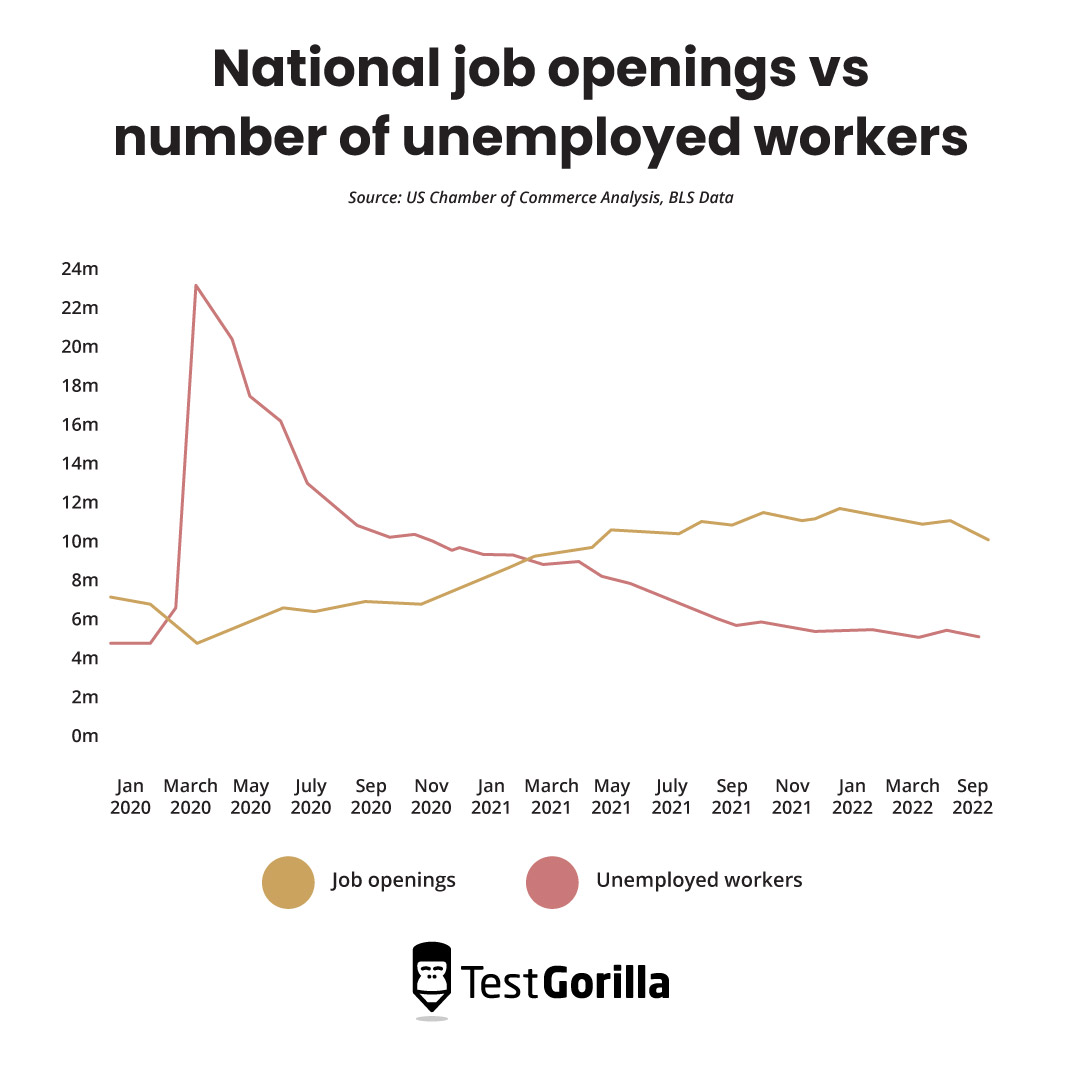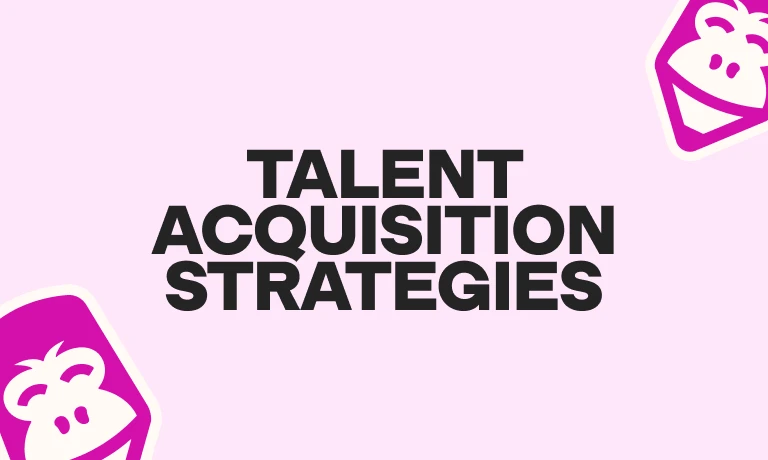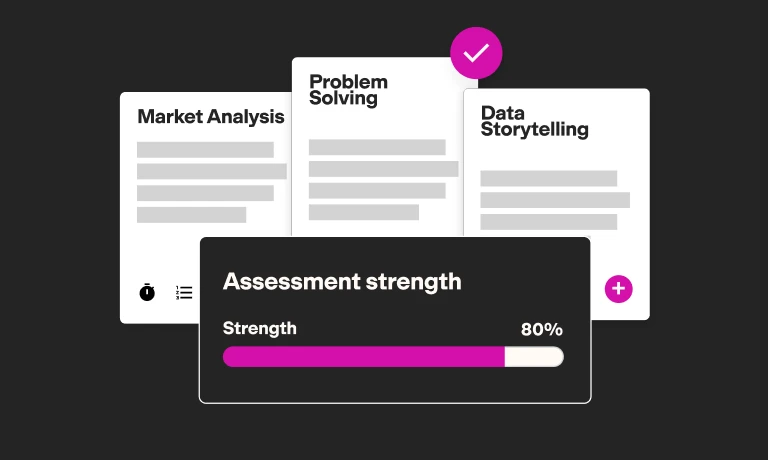How skills-based hiring can change the way we view retention and internal mobility
Career progression is, understandably, front-of-mind for employees when evaluating whether to stay with their current employer or search elsewhere. In 2022, more than a third of workers said that they planned to ask for a raise in the coming year.[1]
Many workers are not afraid to take drastic actions if their raise is withheld or unsatisfactory.
There’s a common belief among workforces that when it comes to career progression, “the only way up is out.” If employees want to ascend to a position that utilizes their leadership skills, they expect to have better luck finding one outside of their organization than inside it.
This attitude persists because many employers are of a similar opinion. Losing talented employees because they weren’t offered opportunities to progress is viewed as inevitable, with glass-half-full employers seeing it as an opportunity to take on a fresh new hire.
To some, overly ambitious employees may be seen as “disruptive” to the business’s operations. Therefore, letting that talent go would be considered beneficial in the long run.
However, this blasé attitude to employee retention and internal mobility isn’t sustainable. It comes at a cost to your business and could be hindering your growth.
In this blog, we look at the state of employee retention and how skills-based hiring can help transform this “only way up is out” attitude among both employers and employees.
What’s the state of employee retention?
Employers are experiencing a crisis when it comes to employee retention: A whopping 50.5M people in the US quit their jobs in 2022, up from 47.8M in 2021.
To understand why this is, there are a few key factors you have to consider.
The Great Resignation
Much of the current state of employee retention is due to the lingering effects of the Covid-19 pandemic.
In 2020, lockdown orders caused unemployment to spike higher in just three months than it did during two years of the Great Recession. This trend continued into the following year, as the number of people in employment in February 2021 was 8.5M less than in February 2020.
Younger workers were particularly affected. The unemployment rate among those aged 16-24 rose from 8.4% to 24.4%, a threefold jump that was almost twice as big a leap as the rate for workers aged 25 and older, which only rose from 2.8% to 11.3%.
As society opened back up, however, demand from customers returned to normal much quicker than expected.
Employers found that many workers were reluctant to return to the roles they’d been axed from just months before, but the pandemic tragically claimed the lives of a sizable portion of the workforce while many older workers had decided to retire early.
All of this meant that the number of job openings surpassed the number of unemployed workers in spring 2021, transforming the employment landscape into a candidate’s market. This means the shortage of skilled workers gives candidates more choice and bargaining power with the roles they apply for.
The candidate’s market doesn’t just affect the unemployed. It also has an impact on retention, giving current employees more incentive to leave their roles because they know they may be able to command a more senior role and a higher salary elsewhere.
Many workers took this option, leading to what is now known as the “Great Resignation.” The effects are far-reaching: 73% of Fortune 100 chief executive officers say that they expect the work shortages brought on by the Great Resignation to cause continuing disruption to their organizations.
The Great Resignation may make it especially challenging to retain younger workers, who have a far better understanding of workers’ rights than previous generations, meaning they have less tolerance for being treated unfairly.
US government data shows that the median employee tenure is higher among older workers than younger workers, since those aged 25-34 stay for just 2.8 years with their employers compared to 9.8 years for those aged 55-64.
A “churn and burn” attitude
We can see that the Great Resignation was at least partially driven by the wave of layoffs at the height of the pandemic, which left many workers disillusioned as to the value they represented to their employers and the security they could expect in return.
Another powerful factor behind the Great Resignation and ongoing retention crisis is the toxic culture in many workplaces, which was put on display during the pandemic.
Although the switch to remote work, when managed correctly, can bring boosts to productivity and greater freedom for employees, the reluctance with which many employers adopted remote working practices intensified toxic cultures.
A shocking 63% of workers claim that their companies have not made any significant changes to their workplaces to adapt them to hybrid working, leaving employees struggling with mismatched processes.
A common example is employers using remote and hybrid working practices to put greater pressure on worker efficiency and neglecting the benefits it can bring for employee autonomy and work-life balance.
With the economic pressures of the pandemic causing belt-tightening across industries, employees in drastically depleted teams were expected to take on extra responsibilities to “save” their businesses, while a lack of healthy guidance around remote working meant that the boundaries between work and leisure were eroded.
One area in which this is highly visible is sick days. Remote working has raised the bar at many organizations for what illnesses are considered “serious enough” to warrant time off, with remote and hybrid workers often being expected to work even when they’re ill.
Only a third (34%) of US adults said that they actually took a sick day the last time they were ill, with 18% being regular remote workers who simply continued to work from home.
In many organizations, these toxic tendencies have worsened to become a “churn and burn” culture in which employees are hired, rapidly burnt out from overwork and stress, then either fired or driven to quit.
It’s no surprise, then, that many of the top reasons for employees quitting once the employment market improved are related to toxic cultures, including:
Uncaring leaders
Unsustainable work expectations
Unsupportive colleagues
All of these factors create the impression among employees that their skills and expertise are disposable and that their employers do not care enough about them to invest in them long-term, which has a negative impact on retention.
Neglecting employee development
There’s a common theme emerging here: In order to stay at your organization, employees need to feel that they are valued and receiving investment in their skills and expertise.
One of the most effective ways to demonstrate this investment is with learning and development (L&D) programs. As the above infographic shows, a lack of career development opportunities was the biggest reason that employees left their jobs in 2021.
Offering development opportunities can put you a cut above the competition during hiring. Just 34% of workers said they were satisfied with the level of skills development their current employer was offering them, and a separate study found that 48% of American workers would switch to a new job if it offered skills training opportunities.
Research also supports a direct connection between L&D programs and employee loyalty. According to a 2020 LinkedIn Learning study, workers report being more likely to stay at a company if they are involved in its learning and development initiatives.[2]
How poor retention harms organizations
This might be obvious from what we’ve discussed above. However, it’s worth running through the damage that poor retention can do to your business in order to best understand the solutions available.
What does it mean for your business when your turnover rates spike?
1. It’s a symptom of poor company culture and low engagement
It makes sense that the lack of a cohesive company culture contributes to poor employee retention and vice versa.
If your company culture is toxic, with high turnover and low morale among employees, they are likely to disengage from the work that they’re doing and start to look elsewhere for employment. In fact, a Gallup study found that low-engagement teams typically see turnover rates between 18% and 43% higher than teams with high engagement.
This in turn means that your team is always changing, making these effects difficult to reverse as colleagues struggle to form connections with each other. Plus, the stress of tasks constantly falling through the cracks during employee handovers causes even more resentment and dissatisfaction.
The result is a death spiral in terms of employee morale, which can make it hard to attract and secure new recruits.
Job seekers rank company culture highly when deciding to take a role, with 86% saying it is either somewhat or very important. Whether they read up on your poor culture online or sense it during their interview, it can damage your chances of attracting a top candidate.
2. This has knock-on effects on productivity
Naturally, as your average employee tenure drops, so too will your productivity. This is for a number of reasons:
Employees aren’t around long enough to become confident in their roles
You’re constantly losing institutional knowledge
Employees find it harder to form relationships with each other, causing morale to dip
The effect may worsen over time because poor retention entrenches a culture of disengagement: The Gallup study quoted above found that teams who landed in the bottom quartile for engagement were 23% less profitable than those in the top quartile.
As we’ve already seen, low engagement and retention are often signs of a lack of investment in employee development. Though the productivity loss caused by the failure to keep up with changing skill requirements cannot be considered a direct impact of poor retention, we might consider it an indirect outcome.
One study found that 59% of hiring managers expect technological innovations like AI and automation to cause a serious shift in the types of skills they require from employees, yet only 16% of organizations expect to make significant investments in learning in the next three years.[3]
3. It damages your employer brand
As we’ve touched on briefly already, all of the above impacts how difficult it is to attract top candidates when you need to refill roles.
This is largely because of the impact that poor retention has on your employer brand – in other words, how candidates perceive working for your organization when they apply.
It’s never been easier for candidates to share their opinions on their employers with other job seekers, and many candidates use websites like Glassdoor to do a background check on a potential new workplace. Indeed, 60% of candidates choose a place to work based on their beliefs and values.
It follows, then, that if a candidate sees reviews saying that you have a culture of causing burnout and high turnover, it’s highly likely they either won’t apply or will ghost you during the application process.
This is never a good thing – many employers may believe that they can “weed out” candidates that aren’t up to the “challenge” of working for them, but the truth is that the smartest (and thereby most competent) candidates avoid poorly rated companies like the plague.
4. It costs you money
Finally – but perhaps most compellingly in the eyes of senior leadership – poor retention costs you money. This is due to multiple factors, including:
More potential healthcare outlays due to burnout
Loss of productivity
More frequent hiring expenses
Longer time-to-hire due to the difficulty of attracting candidates
One case study found that retaining a single salesperson for an extra year, as well as making investments in onboarding and better management, yielded a difference in $1.3m in net value for the company over a three-year period.[4]
So, it’s simple: Retain your workers, avoid the need to constantly rehire, and make your company as appealing to candidates as possible in order to save more money. It’s a win-win.
While the goal is simple, the causes of the problem in the first place can be a bit more complex. Let’s explore that briefly before talking about solutions.
The best insights on HR and recruitment, delivered to your inbox.
Biweekly updates. No spam. Unsubscribe any time.
How traditional hiring contributes to poor retention
While retention might seem like a problem between you and your employees, in reality, it starts with your hiring practices – and if you’re hiring using traditional methods, these shoulder a lot of the blame.
It starts with when you choose to begin the hiring process.
Traditionally, hiring is thought of as a reactive process that starts when a current employee decides to leave. However, this causes stress for current employees because they struggle with compensating workloads in between hires, particularly if the time-to-hire stretches longer than expected.
The current skills shortages have exacerbated this situation: UK research shows that 38% of staff say their workloads have become unmanageable due to open vacancies on their team.[5]
Traditional recruitment tools, even those as ubiquitous as the resume and unstructured interviews, can also cause bias to cloud an employer’s judgment during the hiring process.
Interviewer bias prevents employers from seeing the potential in marginalized or non-traditional candidates like STARs, or those “Skilled Through Alternative Routes.”
It can also lead to racial disparities in the workforce: A recent study found that applicants with white-sounding names were 9% more likely than those with Black or African-American-sounding names to receive responses from employers, even from identical applications.
Additionally, because traditional hiring is focused primarily on a candidate’s work experience – such as whether they’ve previously completed the tasks required in the open role – and not on direct measurement of their skills, hiring managers only have a limited view of their potential.
This means that once these candidates enter your workforce, you may struggle to provide the meaningful development and career progression they crave.
One way this commonly manifests is through the “Peter Principle,” a concept from a 1971 book of the same name by Peter J. Laurence and Raymond Hull.
The Peter Principle refers to when an employee is promoted within the same career path until they stop being competent in their role, as opposed to their employer providing supportive training to help them continuously improve and succeed.
The Peter Principle fuels attrition because it gives employees only one path forward in their careers, forcing them to turn to other employers if they want to explore a new business area or develop new skills.
Even if you are open to offering employees redeployment opportunities or the chance to internally move to more fulfilling roles, traditional hiring makes this harder by giving you little idea of an employee’s key skills or areas for growth.
This is why, although upskilling is part of the answer, real change starts from the ground up with your hiring process.
How skills-based hiring transforms hiring and retention
We’ve now seen:
Where the retention crisis employers are facing comes from
How it harms your business
How traditional hiring holds you back from addressing it
It’s time to talk solutions.
If you ask us, the best place to start is with skills-based hiring. Deloitte found that skills-based organizations were almost twice as likely to retain high performers and more than twice as likely to innovate.
The State of Skills-Based Hiring 2024 found that 90% of employers saw an increase in retention after switching to skills-based hiring methods, and 81% reduced their time-to-hire.
Now, let’s explore how skills-based hiring transforms retention in organizations and ultimately saves you money.
How skills-based transforms hiring and retention: Summary table
Do you feel like your organization is a sinking ship? Need to patch the cracks fast? Here’s a quick breakdown of how skills-based hiring can help.
Traditional hiring | Skills-based hiring | Skills-based hiring’s effect on retention |
Reactive: occurs after or just before an employee leaves | Proactive when you anticipate a skills gap or an uptick in demand | Reduces stress for current employees from fluctuating workloads |
Uses resumes to screen candidates | Uses skills testing to screen candidates | Candidates are a better fit for their roles and employers have a better overview of their skills to offer development opportunities to help them stick around |
Looks for “culture fit” | Looks for “culture add” | Instead of hiring employees based on superficial factors, organizations select employees who share values but think differently, reducing the likelihood of cliques forming |
Opens the door to bias | Focuses on competency over identity | Creates a more diverse workforce, which is connected to better retention |
Doesn’t always show employers areas for growth in candidates | Gives employers an overview of candidates’ skills from the start | Employers have an overview of employees’ skills so they know which gaps to fill with training |
Encourages employers to define candidates by their experience | Encourages employers to focus on candidates’ potential | By giving employers an overview of the skills in their organization, employers can “shop” their own workforce for the skills needed for new projects or roles, enabling internal mobility and effective redeployment |
Encouraging proactive hiring
Skills-based methods are best used proactively, in other words, not as a response to a sudden vacancy, but planned into your organization’s growth or in anticipation of a skills gap in your workforce.
For instance, you might be planning to scale your hiring in the coming years and may need to raise your employer profile before doing so.
Instead of putting the big task of recruitment marketing onto the plate of an already overstretched HR team, plan and budget in advance to hire a new team member to cover these responsibilities.
Proactive hiring isn’t about hiring somebody before they’re needed; it’s about preparing in advance of hiring so that you can hit the ground running when the role becomes necessary. You can do this by:
Identifying skill gaps in your workforce
Creating an ideal candidate persona with the skills required for the role
Building a talent pool of internal and external candidates
Engaging and connecting with potential candidates before the role officially opens
As you do so, rather than exclusively considering the experience that candidates have, think about the skills they need. In the above example, the candidate would need to understand HR fundamentals, of course, but also social media management and strategy.
By encouraging a proactive approach, skills-based hiring ensures that teams are not pushed to the breaking point before a new hire is made; this improves the likelihood that your existing team stays on while also benefiting the experience of your new hire.
Using skills testing to screen candidates
With your core competencies in mind from your proactive research around the role, you can then use skills testing to screen candidates.
This is a more efficient and less biased alternative to the traditional resume. It enables you to shortlist only those who demonstrate the skills for the role and also compare candidates objectively based on their performance.
It’s also a significantly better predictor of job performance than traditional hiring, which has further knock-on effects on retention.
It’s not rocket science: If people feel competent in their roles, they’ll stay with you longer. According to our State of Skills Based Hiring report, 72.1% of people hired via skills-based hiring report are happy in their role compared to 62.8% of those hired without it.
Employees hired with skills-based hiring also plan to stay longer in their roles. Our research found that only 3.2% of employees hired with skills-based methods planned to leave their roles in the next year, compared to 7.3% of those recruited traditionally – more than double the amount.
Hiring for culture add
With candidates’ skills verified by testing, you’re free to focus on not just finding a competent candidate but shaping your company culture. The best way to do this is to hire for “culture add” instead of the traditional concept of “culture fit.”
The concept of culture fit is represented by the “beer test,” in which the interviewer subjectively assesses whether they would like to “have a beer” with the interviewee. This can lead to hiring candidates who reproduce the qualities of your existing team and lead to cliques forming within your organization – not good for retention.
Culture add, on the other hand, doesn’t ask that employees mirror their colleagues, but that they bring something new to the conversation. Think of it like assembling a quiz team: If everyone’s area of expertise was sports, the music round would be a real killer. But with a balance of specializations, you could take home the top prize.
Hiring for culture add minimizes the risk that cliques form, reducing workplace stress and maximizing the chances that the new candidate sticks around. Deloitte research shows that diversity of thinking increases innovation by about 20%.[6]
Diversifying your workforce
We’ve touched on the effect that bias in traditional hiring can have on your team, particularly during resume evaluation. Skills testing is a much less biased alternative because it enables you to view a candidate’s skills directly and anonymously, limiting the effects of unconscious bias on your selection.
The research shows that this does help you create more diverse teams. Our 2022 report found that 91.1% of organizations saw an increase in diversity after switching to skills-based hiring.
This helps promote retention: Higher levels of cultural and gender diversity as well as the presence of HR policies focused on this issue have been linked to lower employee turnover in many organizations.
You might think that’s the end of it, but the impact of a skills-based hiring approach carries on long after the hiring is done.
Spotting avenues for employee development
While there’s nothing about traditional hiring that stops you from pursuing upskilling – and indeed, upskilling is becoming the norm across industries – it isn’t as effective without the skills insights you gain from a skills-based hiring method.
Skills-based hiring methods go hand-in-hand with employee development because they give you an overview of the skills available in your workforce. For instance, they enable you to input the skills data you collect from new employees during hiring into an internal talent marketplace: a database that maps the skills available across your workforce.
With this in place, you can better identify skills gaps – the lack of a specific skill in your organization – before they occur by comparing your teams’ capabilities to their upcoming goals. You can then create upskilling or hiring plans to support these teams to meet their targets and avoid attrition-inducing burnout.
Skills tests also help you track employees’ skill development – for example, you might compare their score on a skills assessment upon their entry into the company to their score on the same test after three months of training to see how much they’ve progressed.
All of this makes for a more fulfilling development experience for employees and a lower likelihood that they’ll leave your organization
Identifying opportunities for redeployment and internal mobility
Finally, proactively mapping the skills of your workforce and identifying opportunities for employee development promotes that all-important internal mobility, incentivizing candidates to stay longer with your organization.
You might routinely test employees’ leadership skills to identify candidates for management training or upcoming management roles.
You might also use skills tests to identify opportunities for redeployment. If an employee wants to try a different career path, you can assess their skills and use training initiatives to develop them into their desired role within your company.
Any of these uses of skills-based development show employees that you’re tailoring their employment experience and investing in them for the long term, which helps them imagine a long future at your company. In fact, if you do it really well, they may even boomerang back to your organization after leaving.
Prioritizing internal mobility is your biggest ally in the fight against attrition.
A study by the Society for Human Resource Management found that employees who were promoted within three years of being hired had a 70% likelihood to stay on board in the long run, with those making lateral moves not far behind at 62%. Those who weren’t able to move internally had just a 45% chance of remaining.
Boost your retention and hiring efforts by assessing your employees’ skills
In this blog, we’ve discussed:
The factors influencing employee retention rates
How poor retention harms your business
The lack of support traditional hiring gives you when it comes to preventing attrition
How skills-based hiring can help you kick the perception that “the only way up is out,” this time for good
If you’re ready to start tackling poor retention in your organization, read our blog on six ways to reduce employee turnover.
If you want to craft killer learning and development initiatives, then read our guide to learning and development.
Or, if you’re ready to put skills-based hiring to the test, use our Motivation test to find candidates who share your organization’s vision.
Sources
“PwC’s Global Workforce Hopes and Fears Survey 2022”. (2022). PwC The Leadership Agenda. Retrieved March 28, 2023. https://www.pwc.com/gx/en/issues/workforce/hopes-and-fears-2022.html
“2020 Workplace LinkedIn Learning Report”. (2020). LinkedIn Learning. Retrieved March 28, 2023. https://learning.linkedin.com/content/dam/me/learning/resources/pdfs/LinkedIn-Learning-2020-Workplace-Learning-Report.pdf
“The Future of Workforce Development”. (2018). Salesforce. Retrieved March 28, 2023. https://www.salesforce.com/content/dam/web/en\_us/www/documents/research/market/future-of-workforce-development-salesforce-research.pdf
Josebachvili, Maia. (August 29, 2016). “How to understand the ROI of investing in People”. LinkedIn. Retrieved March 28, 2023. https://www.linkedin.com/pulse/how-understand-roi-investing-people-maia-josebachvili/
Roberts, Cherilyn. (April 21, 2022). “Hiring Trends Index: a look at the recruitment landscape of Q1 2022”. Totaljobs. Retrieved March 28, 2023. https://www.totaljobs.com/recruiter-advice/hiring-trends-index-a-look-at-the-recruitment-landscape-of-q1-2022
Bourke, Juliet. (January 22, 2018). “The diversity and inclusion revolution: Eight powerful truths”. Deloitte Insights. Retrieved March 28, 2023. https://www2.deloitte.com/us/en/insights/deloitte-review/issue-22/diversity-and-inclusion-at-work-eight-powerful-truths.html
You've scrolled this far
Why not try TestGorilla for free, and see what happens when you put skills first.




















